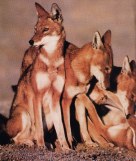 Wolves WolvesWolf History, Conservation, Ecology and Behavior
[www.wolfology.com]
|
Wolfology Item #1307
Source
v80 n1 (February 1999)
Click on the journal title (above) for information on acquiring the complete article
|
 |
Status Survey and Conservation Action Plan, the Ethiopian Wolf
Minna J. Hsu
1999
|
Abstract
Hsu reviews Status Survey and Conservation Action Plan, the Ethiopian Wolf, by C. Sillero-Zubiri and D. MacDonald. (entire text)
 This book presents the most comprehensive review of the current population, distribution and conservation status of the Ethiopian wolf, Canis simensis. Among the 34 living canid species globally, the Ethiopian wolf is considered the most endangered with a remaining population of about 400 individuals restricted to the highlands of Ethiopia. Nine experts on the biology of the Ethiopian wolf contributed data for the successful completion of this action plan. The book highlights the ongoing struggle to save an endangered mammal from extinction in Ethiopia. If steps are not taken immediately, the Ethiopian wolf likely will disappear from our planet like the Falkland Island wolf, Dusicyon australis, which became extinct in 1876. This book is a valuable conservation tool for biologists, politicians, and policy makers since it provides future strategies for the conservation and management of Ethiopian wolves and their habitat. Information on the habitat loss, persecution by local people, hybridization threat from domestic dog population, and diseases are also discussed in detail....
....The authors...argue for the need for, aims of, and structure of this conservation action plan. The first chapter describes the conservation and legal status of the Ethiopian wolf and includes a brief summary on taxonomy, morphology, habitat selection, diet, spatial organization, mating system and cultural significance. The distribution and population status of the Ethiopian wolf are discussed in chapter 2. These wolves are endemic to the high montane ecosystems or afroalpine and subalpine ecological zones of Ethiopia. They are specialized rodent hunters and are believed to have evolved in Ethiopia during Pleistocene glacial periods. The population size of wolves was 340-520 during 1992. The wolves now are restricted to a half dozen isolated sites, and the largest population of wolves has been recorded in Bale Mountain National Park where the wolves have been monitored by field biologists since 1983. Other large populations outside of Bale are found in the Menz, Shoa, and Arsi Mountains. It is alarming that from about 440 adult wolves in 1990, the population in Bale decreased drastically to 205-270 by 1992 due to increased human persecution and disease epizootics.
In chapters 3, 4, and 5, the authors discuss several factors affecting the survival of wolves in Ethiopia, including how their prime habitat, the afroalpine and subalpine ecozones, has been increasingly denuded and fragmented by humans and livestock. Although wolves are tolerated in sites such as Arsi and Bale, they are persecuted in other northern populations where they have been accused of killing small domestic stock. In the past, Ethiopia was ravaged by war, which inflicted some damage to the wild populations of wolves. Occasional mortality also results from roadkills because urbanization is expanding into their habitat. However, the presence of large numbers of domestic dogs in prime wolf habitat, such as the Bale Mountains, is a serious threat since dogs transmit diseases (e.g., rabies, canine distemper, canine parvovirus) to the wolves, increase the risk of interbreeding, and compete for food. The authors suggested control of the dog population to reduce the risk of hybridization and disease transfer as management measures and recommended vaccination against viral outbreaks. Moreover, some of the wolves in the Web Valley population were reported to have unusual appearance, characterized by shorter muzzles, heavier-body builds, and differences in coat patterns; further genetic study indicated hybridization with domestic dogs....
Population viability analysis was discussed in chapter 6. Use of computer software (VORTEX) suggests that in the absence of threats from diseases and hybridization, the wolf population appears to have a positive growth rate. The population viability analysis also recommended population supplementation with translocated or captive-bred females....[T]he book also recommends a sound captive breeding program (chapters 8 and 9). In fact, the New York Zoological Society initiated a proposal in 1992 to captive breed Ethiopian wolves in the United States, but the Ethiopian government was reluctant to provide animals necessary for a captive nucleus; thus, the plan did not prosper. However, the authors state that a new proposal has been developed in collaboration with Born Free Foundation to set up a wolf breeding center in Ethiopia, an effort that certainly deserves support from the local government.
Details of the Ethiopian wolf conservation action plan are outlined in chapter 10. About 25 issues have been discussed in the action plan ranging from community conservation education to fund raising and from habitat conservation to genetic management of Ethiopian wolves....
END
|